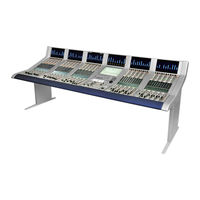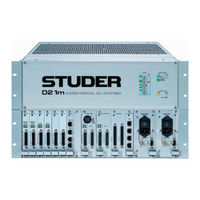Studer Vista Audio Mixing Console Manuals
Manuals and User Guides for Studer Vista Audio Mixing Console. We have 3 Studer Vista Audio Mixing Console manuals available for free PDF download: Operating Instructions Manual, Product Information
Studer Vista Operating Instructions Manual (713 pages)
Digital Mixing System
Brand: Studer
|
Category: Recording Equipment
|
Size: 66.31 MB
Table of Contents
-
-
-
Vistonics17
-
Ganging22
-
Copy/Paste23
-
Scrolling24
-
-
-
-
Introduction77
-
View Change77
-
Global Views79
-
-
Introduction133
-
The GC Screen135
-
The Toolbar137
-
The Status Bar138
-
-
-
Labels141
-
-
-
Sorting Options158
-
Channel Patch166
-
Snapshot Page172
-
Cue List Page186
-
D950 Strip Setup190
-
-
Page Selection202
-
Tools203
-
System Functions208
-
-
-
The File Menu212
-
The View Menu220
-
The221
-
The Option Menu222
-
The User Menu234
-
The Window Menu235
-
The about Menu236
-
-
-
-
-
Basics267
-
MIX Passes272
-
Write Zones273
-
How to274
-
-
-
Description277
-
V2.5 Vs. V3.0277
-
New Features277
-
-
-
-
Static Objects282
-
Dynamic Objects284
-
MIX Snapshot285
-
-
-
File Management287
-
MIX Tree288
-
-
MIX Pass299
-
MIX Pass Stack299
-
MIX Comparison300
-
Undo/Redo301
-
Kill Pass303
-
-
-
Control Modes304
-
Read305
-
Write306
-
Trim308
-
Isolate311
-
-
Local Mode Entry315
-
Vista Mode Entry316
-
-
Touch and Hold324
-
Global Record336
-
Pre-Selectors336
-
Write Zone337
-
Auto GPI In/Out340
-
-
-
Write to341
-
Extend Back to345
-
Glide347
-
-
-
Switch Operation353
-
Press and Hold355
-
-
General Patch357
-
Channel Patch359
-
-
-
Bus Assignments362
-
GC Menu Items364
-
-
-
MIX on374
-
View Dynamic374
-
View Alt374
-
Function Keys375
-
-
-
Read Lock380
-
-
OFLA Editing387
-
MIX Controls398
-
Active MIX398
-
Merge MIX401
-
-
Edit Types411
-
5.17 User Files413
-
Autotouch+ Panel416
-
-
5.21 MIX Options443
-
Glide449
-
Hold451
-
Master Panel452
-
End of Pass455
-
Miscellaneous456
-
5.23 Hot Keys460
-
-
7.1 Installation469
-
Where to Install470
-
How to Install470
-
-
7.2 Introduction473
-
-
The Core Page505
-
-
The Toolbar506
-
The Edit Menu507
-
The File Menu507
-
The View Menu507
-
The Options Menu512
-
The Window Menu512
-
-
7.5 Maintenance513
-
-
-
Introduction525
-
-
Output Faders534
-
Touch Screen535
-
Mute Groups542
-
-
-
Cue List547
-
Hardware Keys547
-
Creating a Cue548
-
Recalling a Cue548
-
Event Options552
-
Arm Cuelist553
-
Blackout553
-
Xfade Active553
-
Cue List Options554
-
Preview554
-
Matrix Buses559
-
N-X560
-
D21M I/O System565
-
-
Matrix" Busses595
-
Mute Groups598
-
Introduction608
-
-
Cue List610
-
Pfl Broadcast619
-
Mono Summation621
-
-
-
-
Introduction630
-
Channel Patch631
-
Monitoring633
-
Metering634
-
-
Parameters635
-
Global Views636
-
Input Parameters636
-
EQ Parameters644
-
-
-
-
-
-
Input Patching664
-
Output Patching665
-
-
Container.ini675
-
D950System.ini676
-
Control Network677
-
Vista 5677
-
Vista 6, 7, 8677
-
IP Addresses678
-
-
BDAW Control686
-
Basics686
-
Vista Settings688
-
DAW Settings689
-
-
Egeneral Patch707
-
Hchanges710
-
Ichanged Files712
-
Advertisement
Studer Vista Product Information (98 pages)
I/O System Components
Brand: Studer
|
Category: Recording Equipment
|
Size: 6.72 MB
Table of Contents
Studer Vista Operating Instructions Manual (51 pages)
Compact Remote SW Version 5.0
Table of Contents
-
-
3 Operation
39-
Strip Setup39
-
Navigation41
-
Monitoring43
-
-
-
Conferencing47
-
Faderglow47
-
Vista FX47
-
Geq47
-
Mute Groups48
-
Relink48
Advertisement


